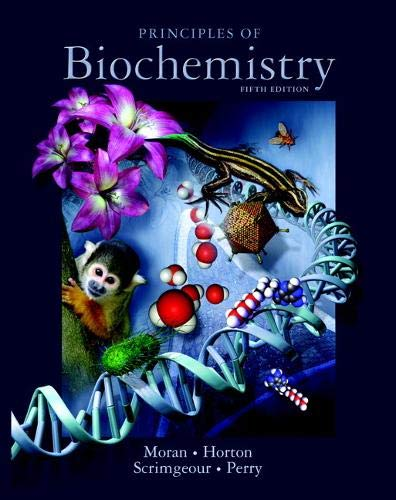Principles of Biochemistry, 5/E

Laurence A. Moran, University of Toronto
Robert A Horton, North Carolina State University
Gray Scrimgeour, University of Toronto
Marc Perry, University of Toronto
ISBN-10: 0321707338
ISBN-13: 9780321707338
Publisher: Prentice Hall
Copyright: 2012Principles of Biochemistry, 5e (Moran/Horton/Scrimgeour/Perry/Rawn)
Chapter 2 Water1) Which statement does NOT explain the polarity of water?
A) Oxygen is more electronegative than hydrogen.
B) Water molecules have a bent geometry (V-shaped).
C) The oxygen in water has sp2 hybrid orbitals.
D) In water the hydrogen carries a partial positive charge (?+).
Answer: C
Page Ref: Section 2-1
2) The polarity of small molecules is a result of
A) the presence of oxygen.
B) the geometry of the bonds in the molecule.
C) the polar covalent bonds.
D) All of the above.
E) B and C.
Answer: E
Page Ref: Section 2-1
3) Which substance do you expect to be most soluble in water?
A) Ammonia, NH3.
B) Methane, CH4.
C) Carbon dioxide, CO2.
D) Nitrogen, N2.
Answer: A
Page Ref: Section 2-1
4) Which is NOT a proper way to form a hydrogen bond? (The symbol "R" represents a general organic group. The hydrogen bonding is represented by dashed lines.)
A) I
B) II
C) III
D) IV
Answer: B
Page Ref: Section 2-2
5) What is the maximum number of hydrogen bonds that one water molecule can have with neighboring water molecules?
A) 1
B) 2
C) 3
D) 4
Answer: D
Page Ref: Section 2-2
6) Which statement is true about hydrogen bonds between water molecules?
A) They are about as strong as the covalent bonds in a water molecule.
B) They arise because of the linear geometry of water.
C) They cause water to have an unusually low freezing point for its molecular weight.
D) They involve the unequal sharing of a proton between water molecules.
E) In liquid water the same molecules attract to each other over long time periods.
Answer: D
Page Ref: Section 2-2
7) The abundance of water in the cells and tissues helps to minimize temperature fluctuations. This is due to what property of water?
A) Density.
B) Viscosity.
C) Specific heat.
D) Boiling point.
Answer: C
Page Ref: Section 2-2
8 ) Compounds that ionize when dissolved in water are called ________.
A) electrolytes
B) polar compounds
C) hydrophobic compounds
D) amphipathic compounds
Answer: A
Page Ref: Section 2-3
9) Poorly soluble molecules such as lipids and nucleoside bases can be made more soluble in cells by attaching ________ to them.
A) water
B) oxygen
C) carbohydrates
D) salt ions
Answer: C
Page Ref: Section 2-3
10) Electrolytes dissolve readily in water because
A) they are held together by electrostatic forces.
B) they are hydrophobic.
C) water molecules can cluster about cations.
D) water molecules can cluster about anions.
E) water molecules can cluster about cations and anions.
Answer: E
Page Ref: Section 2-3
11) A molecule or ion is said to be hydrated when it ________.
A) is neutralized by water
B) is surrounded by water molecules
C) reacts and forms a covalent bond to water
D) aggregates with other molecules or ions to form a micelle in water
Answer: B
Page Ref: Section 2-3
12) Which would you expect to be most soluble in water?
A) I
B) II
C) III
D) IV
Answer: A
Page Ref: Section 2-3
13) Solutes diffuse more slowly in cytoplasm than in water because of
A) the higher viscosity of water.
B) the higher heat of vaporization of water.
C) the presence of many crowded molecules in the cytoplasm.
D) the absence of charged molecules inside cells.
Answer: C
Page Ref: Section 2-3
14) The ________ pressure is the pressure required to prevent the flow of solvent through a solvent-permeable membrane that separates two solutions of different solute concentration.
A) hydrostatic
B) electromotive
C) osmotic
D) partial
Answer: C
Page Ref: Section 2-3
15) Which is true about the solubility of electrolytes in water?
A) They are all insoluble in water.
B) They are usually only sparingly soluble in water.
C) They often form super-saturated aqueous solutions.
D) They readily dissolve and ionize in water.
Answer: D
Page Ref: Section 2-3
To view the rest, download the attachment